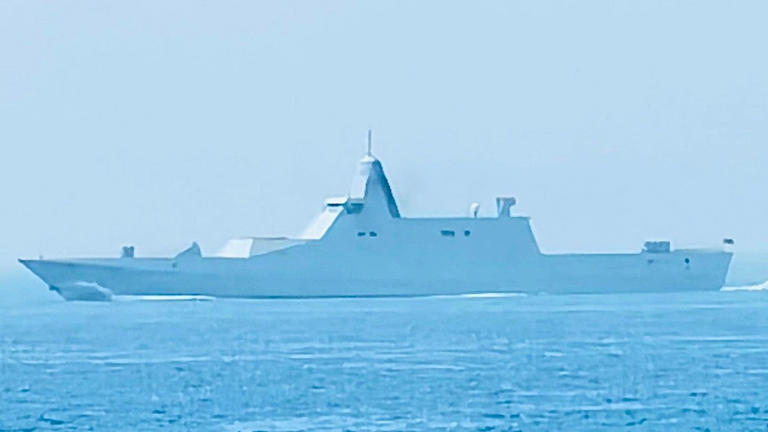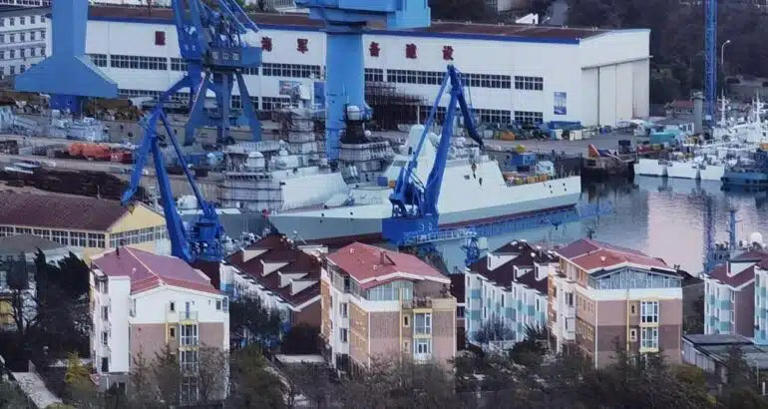China's Mysterious Stealthy Warship Has Headed Out To Sea
Story by Joseph Trevithick

A new stealthy Chinese corvette or light frigate has ostensibly made its maiden voyage. The ship's design has some broad similarities to Sweden's radar-evading Visby class corvettes, including a main gun that sits concealed inside low observable cupola when not in use, but is larger by all indications. How fast work on this vessel seems to be progressing also speaks to the scale and scope of China's shipbuilding capacity, something that presents huge challenges for even the country's most well-equipped competitors, principally the United States. Just two weeks ago, China's first indigenously-designed carrier, which features catapults and other major enhancements, also set out on its inaugural sea trials.
Images of the ship at sea emerged on social media over the weekend. Exactly when the ship left port, where it has sailed, and whether it has already returned to port, are unclear.
The first clear look at this ship emerged in November 2023, in the form of a picture taken at Liaoning Shipyard, also known as Dalian Liaoning South Shipyard. Satellite imagery indicates that the vessel had been under construction there since at least August of last year, according to Tom Shugart, an adjunct senior fellow at the Center for a New American Security (CNAS) think tank.

China's mysterious stealthy ship pictured in November 2023. Unknown author/Chinese internet
In addition to the concealed main gun on the bow, the picture that appeared online last November looked to show a vertical launch system array in front of the main superstructure and a flight deck at the stern. From what we have seen to date, the ship otherwise has a design that puts a premium on low-observable (stealthy) features. These include an integrated mast structure atop the bridge and a lack of major aerials and radar-reflecting fixtures on its superstructure or deck. Smooth planar and faceted surfaces that are inward canted above the ship's waist dominate its design. This is similar to a tumblehome-like configuration which gets progressively narrower above the waterline, but in this case, the lower hull remains outwardly flared. Sweden's stealthy Visbly class corvettes and the U.S. Navy's Zumwalt class stealth destroyers feature forms of tumblehome designs.
Swedish Visbly class corvette HSwMS Karlstad and a Royal Navy Merlin helicopter take part in a surface exercise with partnering NATO warships whilst participating in BALTOPS 20, June 12, 2020. Dan Rosenbaum/MOD USS Zumwalt (DDG 1000) transits the Atlantic Ocean during acceptance trials, April 21, 2016. U.S. Navy
Size-wise, Shugart has estimated the length of the new stealthy warship to be around 97 meters (318 feet) based on comparisons to non-stealthy Type 056 corvettes — NATO reporting name Jiangdao class — also seen in the relevant satellite imagery below. The baseline Type 056 is known to be 90 meters (295 feet) long, as well as having a displacement of around 1,500 tons. Liaoning Shipyard has also produced Type 056s in the past.
What intended uses China has for its new stealthy vessel remains unclear. Andreas Rupprecht, a longtime China observer and contributor to The War Zone, wrote on X that it most likely represents an undesignated "comprehensive test platform," based on the information he found.
Shugart noted much the same in response to questions we put to him about the ship via email. "There have been rumors that this design is some kind of test platform, and that might be the case," he said. "Or it might be the PLA Navy’s next class of corvette — at this point, it’s hard to know for sure. That said, we have yet to see construction of any additional hulls of this type, whereas with the construction of the new Type 054B frigate, we quickly saw units under construction at multiple shipyards. Perhaps the PLA Navy will take a wait-and-see approach, as this is quite a different design, with what appears to be a focus on low-observability features."
Regardless, a new class of stealthy corvettes would be very valuable for the PLAN, and could be used in a number of roles, particularly in littoral zones.
"Assuming this class ended up being a replacement for older Chinese corvettes, I would expect it to have a role in escort missions, anti-submarine warfare (ASW), and perhaps point air defense," Shugart said. This would be broadly similar to the multi-mission capability of the aforementioned Type 056 corvettes when in service with the PLAN. In late 2021, the PLAN began transferring its 22 Type 056 corvettes, the first of which was commissioned in early 2013, to China's Coast Guard. The PLAN presently has 50 Type 056A corvettes in active service, the first of which was commissioned in late 2014, which primarily perform ASW operations.
However, unlike the Type 056, the mystery vessel's stealthy qualities could be particularly attractive for the PLAN. Still, it is important to remember that its low observable design does not make it invisible to radar; but it does make the vessel harder to spot and classify on radar at a distance. It would be especially challenging to pinpoint and engage at long ranges in littoral zones due to it appearing like, and blending in with smaller boat traffic on radar and operating among the geographic clutter.
Congested littoral zones, like those within the First Island Chain, are of critical significance to the PLAN. An area of the Pacific inside a boundary formed by the first line of archipelagos out from mainland East Asia, the First Island Chain encompasses islands Beijing lays claim to, such as the Senkakus. Moreover, the First Island Chain also stretches into the highly strategic South China Sea. Beijing has declared that the vast majority of that body of water belongs to China, and has militarized much of the region — namely via the construction of man-made island fortresses.
A Pentagon infographic showing the geographic boundaries of the First and Second Island Chains. U.S. DoD

There is also the possibility that a stealthy new corvette fleet could be used by the PLAN in a dedicated mainland coastal defense capacity; allowing other vessels, like Type 054A frigates, to conduct other blue water-type missions.
It should also be mentioned that the appearance of the stealthy corvette fits with the broader trend towards heavily armed corvettes and light frigates globally.
Whatever the case, there's little doubt that the development of the mysterious stealthy vessel has been extremely fast — even by Shugart's estimations. "The fact that the new corvette is already on sea trials constitutes an incredibly fast construction timeline. I first spotted the ship under construction in August of last year, and now we have the ship on sea trials in May, nine months later," he told us.
This is of course symptomatic of China's rapidly expanded shipbuilding capability of late. Almost a year ago, the Office of Naval Intelligence sounded the alarm that China's shipbuilding capacity is over 200 times that of the U.S. Mixed in with this, the country has been able to build increasingly more capable ships too, meaning that quality is improving, at least in some regards, with overall quantity.
In contrast to China's rapid shipbuilding, "the U.S. Navy’s new Constellation class frigate was originally scheduled to have a 48-month period from construction start to delivery, and now we have statements from the Navy of significant delays past that timeline," Shugart said.
It will be interesting to see what, if anything, comes of China's new stealthy ship. But, if the speedy construction of the vessel is anything to go by, it is likely we won't have to wait long to find out what that is.










